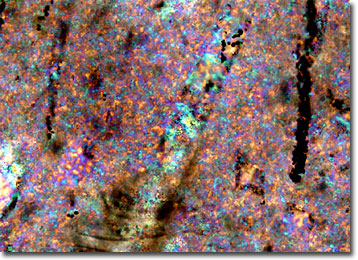Polarized Light Microscopy Digital Image Gallery
Flint
Flint is a type of fine-grained quartz that is hard, yet may be readily chipped into various shapes via percussion or pressure. It is for this reason that the mineral was widely utilized by primitive man to construct weapons and tools.

Flint occurs in a variety of colors depending upon the impurities it contains, but is most often brown, dark gray, or black. A fairly common type of flint called chert, however, is usually much paler than other varieties. Flint may also exhibit a white coating if it is mined from chalk or other lime-containing deposits, and several varieties of the mineral take a good shine when polished. Thus, flint is sometimes utilized in jewelry and ornamental items. In fact, flint is the official gemstone of the state of Ohio, where commercially valuable deposits of the material can be found.
The majority of flint deposits are associated with oceanic limestones, and it is generally believed that the silica necessary to form the substance stemmed from the siliceous spicules of sea sponges. Though typically large and relatively common, flint deposits are absent from many locations, a fact which required many early peoples to travel substantial distances in order to obtain the material. In the Midwestern United States, for instance, there is evidence that suggests that early Native Americans undertook periodic expeditions to flint deposits in Ohio and other areas in order to acquire adequate amounts of flint to construct knives, arrowheads, scrapers, and similar implements. Indeed, tools composed of Ohio flint have been found as far west as Kansas and as far east as the Atlantic seaboard.
